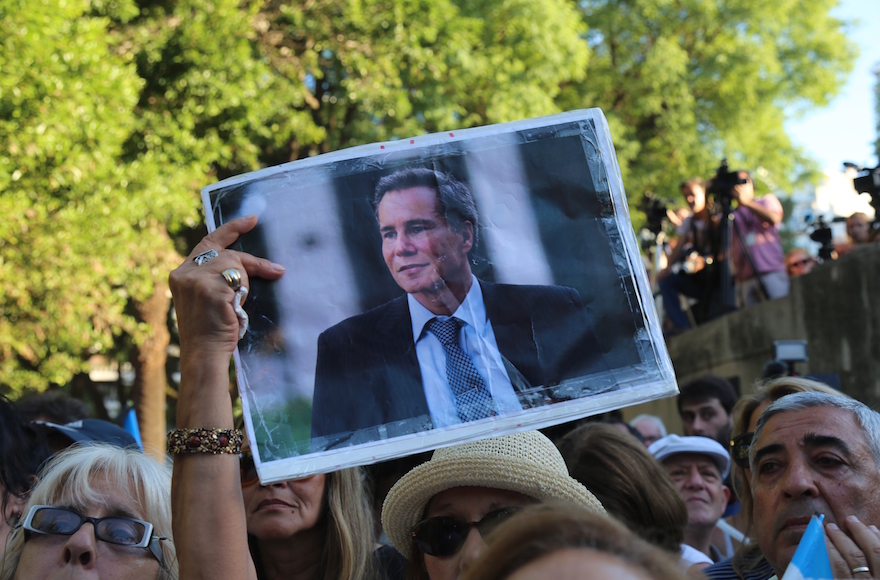Honor Alberto Nisman’s sacrifice by continuing his probe of Iran
Published January 18, 2017

A protester holding up a photograph of Argentine prosecutor Alberto Nisman on the first anniversary of his death, Jan. 18, 2016. (Omer Musa Targal/Anadolu Agency/Getty Images)
WASHINGTON (JTA) — On Jan. 18, 2015, Argentine terrorism prosecutor Alberto Nisman was found dead with a gunshot wound to his head in what was almost certainly murder, not suicide. Whoever murdered him didn’t just want to kill him but rather his body of work. They wanted to bury the revelations he was about to make the very next day in front of the country’s Congress.
ADVERTISEMENT
Nisman was in charge of investigating the 1994 bombing of the AMIA Jewish center that killed 85 people, making it Argentina’s deadliest terrorist attack. He assembled compelling evidence against senior Iranian officials whom he accused of masterminding the bombing. In 2007, on the basis of evidence compiled by Nisman, Interpol issued red notices for five Iranian officials. These red notices, akin to international arrest warrants, remain a black mark on their reputation.
In the case he was due to present in person to Congress, Nisman revealed other devastating evidence, this time against Argentina’s then-president, Cristina Fernandez de Kirchner. Nisman had legally secured thousands of wiretaps of Kirchner allies, Foreign Minister Hector Timerman and Iranian agents operating in Argentina. Nisman said the wiretaps and other evidence proved Kirchner was plotting to find a way to lift the red notices and buy immunity for the Iranian officials he held responsible for the AMIA attack in exchange for expanded trade with Argentina.
Nisman’s exhaustive investigations also found that Iran used its embassies, mosques and cultural centers to radicalize and recruit from the local population.
While Nisman’s death precluded him from presenting his accusations to the Congress, and Kirchner supporters spent almost two years deliberately keeping the complaint from being investigated in the courts, this month an Argentine court agreed to open an investigation into the allegations he assembled.
ADVERTISEMENT
Some of the wiretaps discussed fabricating “new evidence” that would have been presented to a joint Iran-Argentina “truth commission” that Kirchner had negotiated with Iran purportedly to jointly investigate the AMIA bombing. Nisman believed the truth commission, part of a 2013 Memorandum of Understanding between the two countries, was a mechanism to whitewash Iran’s role in the AMIA attack. The memorandum was found to be unconstitutional before anything moved forward.
According to one account, one of those heard on the wiretaps, a Kirchner supporter, discussed inventing a culprit for the AMIA bombing.
“They want to construct a new enemy of the AMIA, someone new to be responsible,” he said. The blame would be placed on a “group of local fascists.”
Mauricio Macri, who was elected president of Argentina in late 2015, has distanced himself from Iran’s malign activities and taken constructive steps to investigate Nisman’s death. Macri is continuing the investigation into the AMIA bombing.
While opening an investigation into Nisman’s allegations is an important step forward that could prove determinative, it’s unclear whether Argentina’s judicial system will operate without a high degree of politicized partiality. Politics and the justice system remain closely aligned in Argentina, which the World Economic Forum ranked 121st out of 138 countries when it comes to judicial independence. Macri has an opportunity to reform the judicial system as he has begun to do for other parts of the government.
The investigation will have regional repercussions, as Argentina is not the lone target of Iranian penetration in the hemisphere.
In Peru, a Hezbollah operative, Mohammad Hamdar, is on trial. Authorities found bombmaking material and hundreds of photos of high-value Israeli and Jewish targets in his home. Hamdar and his new wife reportedly received money from Hezbollah, Iran’s proxy, to stage their wedding. Hamdar was designated by the U.S. Treasury Department as being a member of Hezbollah’s External Security Organization.
In Venezuela, President Nicholas Maduro recently named Tareck El Aissami to be his vice president. El Aissami is known for his ties to Hezbollah and Iran’s revolutionaries, and reportedly used his previous positions to supply fake Venezuelan passports to Syrian terrorists and drug smugglers.
These and other examples show how Iran views Latin America as a target-rich region for its revolution and should send red flags throughout the hemisphere.
Argentina and the United States can benefit from lessons learned from Nisman’s work.
First, Iran reportedly continues to seek the removal of the AMIA-related red notices. While Argentina must take the lead, the U.S. should support the effort to ensure the red notices are renewed by Interpol when they are up for review in November. There should be no statute of limitations on murder.
Second, the U.S. should support a transparent investigation into Nisman’s death. In addition to recent death threats to the prosecutor investigating Nisman’s apparent assassination, the crime scene has been compromised. Moreover, there has been evidence tampering in both the murder case and the AMIA investigation itself. Macri should have a zero-tolerance policy for this scheme and punish those who have engaged in it.
Tehran’s Argentine agents, such as those heard on the wiretaps, have not been tried or punished. Presumably their nefarious activities continue unfettered. Argentina should monitor their activities and hold them accountable.
Finally, the U.S. government should update the report mandated by the Countering Iran in the Western Hemisphere Act of 2012. General John Kelly, the nominee to become the head of the Department of Homeland Security, understands the challenge and noted that “Iran is willing to leverage criminal groups to carry out its objectives in the U.S. homeland.”
Along with ensuring an impartial examination of his final investigation, heeding the lessons from Nisman’s lifelong work will be a critical element of our national security.
(Toby Dershowitz is vice president for government relations and strategy at the Foundation for Defense of Democracies. Gardner Lange is her research assistant.)















